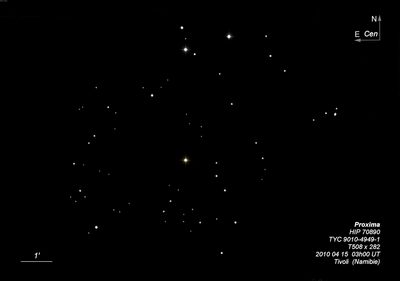
In 1915, R. T. Innes measured the proper motions of stars around α Centauri. At a distance of 2.2 arc degrees southwest of this star, he found a star with a brightness of 10.7 mag, which was moving in the same direction and at the same speed as both components of α Centauri. This red dwarf is actually our closest star to the Sun, only 4.25 light-years away. It is likely part of the α Centauri system, although it orbits at a very large distance. In a few thousand years, when it passes Toliman, it will no longer be our closest star. Proxima, which means "closest" in Latin, occasionally brightens by more than half a magnitude and usually returns to its original brightness within half an hour. Proxima Centauri is a small star, with a mass only 1/10 of the Sun's mass, and it is very faint, shining less than 0.0008 times the brightness of the Sun.